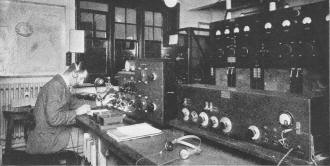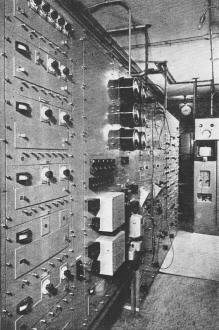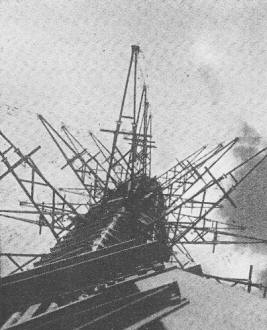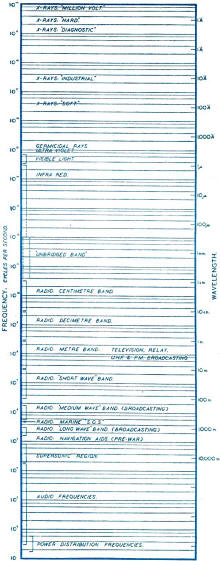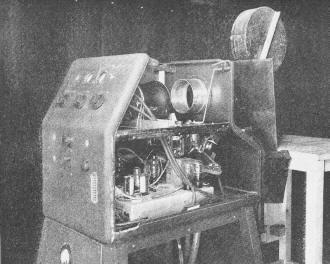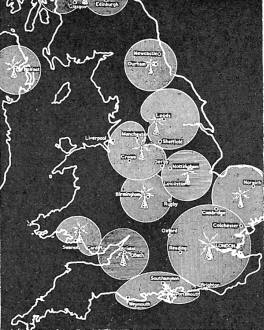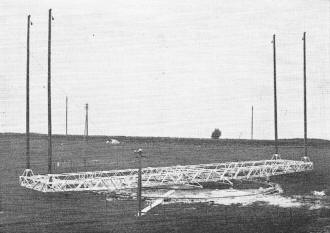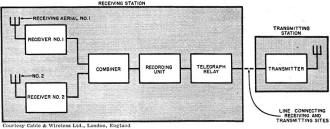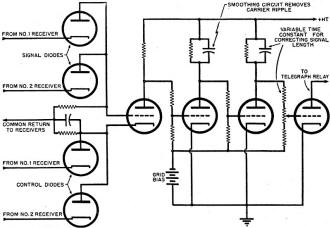The Future of U.H.F. |
||
"The more things change, the more they stay the same," applies to many things, and certainly does for crowding issues in the electromagnetic spectrum. Just as with a gas in an expanding volume, uses for newly opened regions of the radio spectrum are quickly occupied by new users. From the beginning of the radio age, the ability to utilize higher and higher frequencies was limited only by available technology - first vacuum tubes and now semiconductors. Now, as then, it is the higher power transmitting side of the communications equation that governs the upper frequencies. Designing components which work both at high frequencies and high powers is much more difficult than designing for lower powers. Capacitance, inductance, electron travel times, and voltage breakdown barriers are the culprits. This 1945 article from Radio News magazine discusses some of the issues which needed to be overcome in order to expand television broadcasting comfortably into the UHF region. Many industry forces were behind the push in order to open new markets and to squeeze more revenue-producing programming into existing spaces. Somewhat unexpectedly, the advent of cable television (CATV) thwarted well-laid plans for over-the-air broadcasting, and as history shows, UHF languished in the shadow of cable. The Future of U.H.F. - The u.h.f. region will become of utmost significance in providing channels for many miscellaneous services. This Cullercoats coastal radio station will be converted to the ultra-high frequency operation of maritime radio beacons immediately postwar to insure greater safety for ships and trawlers in fog and darkness. By A. Leon Laden London, England Looking at the electromagnetic spectrum chart comparatively simplifies the difficult task of forecasting with any reasonable degree of accuracy the role the higher frequencies are destined to play in the future. It shows the saturation reached in the traditional regions of the radio spectrum and indicates that any future expansion must logically proceed along stereotyped lines and follow the same upward course in the utilization of the metric, centrimetric and millimetric bands as was followed previously in the exploitation of the long-, medium-, and short-wave bands. Moreover, the u.h.f. and microwave bands are ideally suited to meet the channel space requirements for the progressive relocation of existing familiar radio services congested on lower bands and the accommodation of legitimate new services without jeopardizing the scope or volume of tomorrow's brand-new services. Conditioned by improvements in equipment and developments in operating techniques, infiltration into these bands will provide many times more frequency channel space than used at present by all the radio stations in the world or needed for some considerable time to-come. An idea of the prolific fertility of the meter and decimeter bands alone can be gathered from the fact that the span of frequencies extending from 30,000 kc. or 30 megacycles, corresponding to 10 meters, down to 3,000,000 kc. or 3,000 megacycles, corresponding to 10 centimeters, can accommodate the enormous number of 297,000 stations at the present rate of elbow room assigned to broadcasting stations on standard wavelengths. This Port Patrick coastal radio station, erected in 1937, was the first in England to apply commercial u.h.f. multiplex radio-telephony. But even the frequencies contained in the ultra-high-frequency band, which can be defined as stretching from 30,000 kc. or 30 megacycles to 300,000 kc. or 300 megacycles or, expressed in wavelength, from 10 to 1 meters, is impressive enough and can yield 1485 channels, each 200 kc. in width, for frequency modulation or 49 channels, each 6 megacycles in width, for television. Nonetheless, the distribution of frequency bands for use by various services between various countries is extremely complicated and the devising of workable schemes of frequency allocation is not solely governed by mounted radio progress in the sparsely-occupied or barren regions of the electromagnetic spectrum. Apart from a variety of technical considerations it must, necessarily, depend to a large extent on international good will and co-operation. The very-short waves are neither as immune from interference nor as limited in radiation as sometimes assumed. The effects of diffraction and ionospheric refraction can extend the service areas of transmitting stations operating on quasi-optical wavelengths enormously by returning signals to earth at distances up to thousands of miles. (It is claimed that prewar BBC television transmissions radiated on a carrier frequency of about 40 megacycles, i.e. 7 meters in wavelength, from the London station covering nominally an area of some fifty miles, were received in South Africa and in the middle of the United States.) But even on purely optical frequencies quickly absorbed by the water and carbon dioxide in the air, some international agreement will be necessary to avoid severe interference from radar, navigational, industrial, and similar equipment. Undeniably, therefore, the distribution of frequency bands in Europe, based on the allocations as revised at the International Telecommunication Conference held in Cairo in 1938, is totally out of date and inadequate, as no provision was made at the time for police, aeronautical, radio beacons and direction finders, frequency modulation, or facsimile (which all have a place in the allocations agreed upon at the Santiago Conference in 1940 for use in the Americas). Before the war, too, only the U.S.A., England, France, and Germany ran television services and the exploitation of u.h.f. for broadcasting, communication, and other services was very limited in scope of application. It is reasonable to expect wartime radio progress to have contributed, moreover, materially towards enhancing the prospects of various countries claiming u.h.f. allocations for stations post-war, especially since a huge radio-engineering capacity will be available and skilled labor awaits employment. No one can, of course, prophesy future development but it can be envisaged that the internationally constituted governing body which will be set up at the next Telecommunication Conference to lay down requirements of radio governance throughout the world on a revised basis is bound to favor a framework of u.h.f. allocations schemes integrated as a constituent part into a general worldwide radio organization. The vast spectrum area will be re-planned and subdivided and radio services moved about as pawns on a chessboard to balance within the great pattern of a master plan. To facilitate discrimination, frequencies will probably be allocated in separate latitudinal and longitudinal bands on a global scale to countries grouped into regional zones bounded by natural and geographical limits. Certain specifically defined groups of frequencies may well be reserved for international traffic and assigned to geographically-spaced-out, internationally-controlled, fixed units located in "free zones" or international civil aviation centers for operation on shared basis. Such an arrangement would ensure, throughout the world, standardized navigational aids, airport control, services for aircraft in flight, radio beacons and direction finders, press traffic, and certain other services. Another group of frequencies might be assigned to fixed stations catering for countrywide distribution and include military, governmental, broad-casting, communication, and other services designed for internal consumption. Yet another group of frequencies could be allocated to fixed or mobile units for services exclusively restricted to local needs such as county, educational, police, fire, alarms, etc., making it possible to repeat channel assignments at close distances permitting more stations to operate on fewer radio channels. U.H.F. and FM Broadcasting The spectrum utilization chart, reproduced through the courtesy of the British Institution of Radio Engineers, amply evidences the saturated state of the traditional frequency regions. It also indicates that progressive radio and electronic development is bound to necessitate increasing infiltration into higher bands and inaugurate the era of the ultra-short-waves. The wavelength units indicated are meters, centimeters, millimeters, microns (μ), and angstroms. Shared channel working is bound to facilitate multiplication of channels for ultra-high-frequency services comprising sound, vision, and other complementary or independent services in their initial stages of development. High fidelity FM sound services reducing the level of every type of interference and providing noise-free and static-free reception will form an integral part of these u.h.f. services and replace in time common types of modulation. Programs will be transmitted from stations with power outputs ranging from 50 kilowatts down to 5 kilowatts giving coverage over considerable distances free from mutual interference and overlapping between stations, the actual range, of course, depending on the nature of the terrain. For example, Great Britain and Northern Ireland will probably have about twelve stations, separated on the average by less than 150 miles, to cater for the London and more populous districts in the Midlands and Northern and Southwestern areas. Distribution to areas with dense populations will be by coaxial cable networks giving shorter maximum operating range than broadcasting stations on standard wavelengths but improved signal-to-noise ratios. To reduce program cost-per-listener and extend territorial coverage to less populous areas, however, closed line distribution will be discarded in all probability as too cumbersome and expensive (coaxial cable costs about $10, 000 a mile to install) and open aerial transmission used instead. In the course of time, this twin system of diffusion will assume countrywide proportions ensuring almost 100 per cent coverage. Reception of FM programs will take place on low-priced automatic frequency-controlled sets of increased dependability and performance efficiency but decreased in size, containing a minimum amount of metal and fitted with a series of tube devices, brought down from the academic to the mass-production level, governing oscillation and amplification to a much greater degree than possible with conventional tube structures . Cabinets will be made of smooth-faced, highly polished plastics without sharp corners and knobs laying flush with the streamlined body. But the introduction of FM will not necessarily make obsolete conventional type sets; wavelength converters will enable such receivers to operate on the higher frequencies. Television Television will undoubtedly present a far more difficult problem than u.h.f. and FM broadcasting as very wide sidebands are essential for fidelity in the reproduced picture and the width of the band that can be transmitted increases as wavelength is shortened. It may be anticipated, therefore, that the keynote of the television services of the future will be interchangeability. Related to the transition characteristics of the heights and densities of the ionized layers altering under the influence of solar radiation, such services will be capable of short-, medium-, or long-distance operation throughout the space of the year, irrespective of erratic conditions with average suitability. 525-line monochromatic services operating below 100 megacycles will probably be established first of all as part of the countrywide u.h.f. networks; the video portion of the distribution system connecting subscribers living in blocks of flats, housing estates, dormitory suburbs, and built-up areas directly with the transmitting stations as well as distributing to the remoter rural areas in the same way as the audio portion of the network. The pattern of future television developments, however, will be determined by migration to higher frequencies called for by the lack of adequate channel space and the requirements of improved services of wider video bandwidth for color television.
The 300-500 megacycles or 500-1,000 megacycles regions will probably ultimately become the permanent home of television with definition of order of 1,000-1,500-lines, vision bandwidth up to 20 megacycles and the transmission of audio and video signals on the same wavelength. Multipath distortion of pictures in transit, secondary images, and other "ghosts" will be eliminated completely as transmissions on these frequencies will be too high to be refracted by the ionospheric layers or interfere with other stations on same channels. The practical difficulties associated with efficient operation with sufficient power output on increased frequency bands and the different conditions of propagation will involve the abandonment of single-area coverage from high-power transmitters and their replacement by several low-power stations fed by large numbers of substations and relays. Dissemination of the large, clear, steady, detailed, all-electronic pictures radiated from these stations will take place without diffusion over the air by direct or line-of-sight reception on communal aerials distributing over local coaxial-cable networks of rigid frequency characteristics without attenuation of the very broad sidebands. In time, the cloak of mystery enveloping the upper regions of the atmosphere will be torn away revealing the structure and properties of the Kennelly-Heaviside, Appleton, and various other ionized layers. Means will then be found to use the ionosphere as a transmission medium in all its moods. This, in turn, will make possible the setting up of a long-distance television service. Such a service could operate around 1,500-2,000 megacycles and maintain perfect synchronization at the receiving end thousands of miles away at high rate of frames-per-second, providing 2,000-line interlaced, broadband multicolor pictures with much higher definition than at present. New television receivers will be manufactured in quantity and put into the hands of the public at a fraction of the previous cost due to standardization of components and important developments in simplifying equipment. Diagram for British u.h.f. services, illustrating the way in which two British radio engineers propose to cover the populous areas of Great Britain and Northern Ireland with 12 stations, so placed that three separate carrier frequencies would suffice for television and FM services. The frequency bands to be used for various regions are distinguished on the map by different shading. Progress in the cathode-ray tube manufacturing art will bring down the price of these tubes to a few dollars (before the war, cathode-ray tubes cost about 60s in Great Britain; their present cost is about 20s); production facilities and improved workmanship making coaxial cables cheaper and more efficient. Relaying Relaying is a relatively old branch of radio which in its various modern applications will undoubtedly play an ever-increasing part in tomorrow's u.h.f. network systems. Relay units will be called upon to fill the gap wherever line coverage of aural and visual signals will be impracticable, uneconomical, or unreliable. These units will consist of strategically-located substations deriving power from public supply mains or independent Diesel electric power plants employing high-towered aerial arrays for local distribution of programs. Associated with them, satellite installations of unattended and battery-fed amplifying equipment will effect point-to-point transmission along defined routes without wasting a large part of power in indiscriminate radiation. To minimize interference between transmitting and receiving signals, different carriers will be used and the plane of polarization of the waves emitted by the transmitting section of the aerial will be at right angles to that of the waves received by the receiving section of the aerial. On occurrence of a breakdown in any part of such a unit, spare apparatus will be brought automatically into operation and a fault signal given to a central remote-control station. The manifold possibilities of relaying will be recognized in time, adding a powerful tool to ultra-high-frequency utilization. Conditioned by physical and geographical factors, u.h.f. relaying will, at relatively small expenditure, gradually be extended to span continents linking-up with a worldwide system of radio girdling the earth. This will make possible regular transoceanic transmissions hooking up Europe with other continents by the aid of remote-controlled relay units either anchored to the ocean-bed or afloat but self-propelled to maintain a defined position. Single-network world coverage would thus be provided, effecting great" economy in radio spectrum utilization. Within the worldwide framework, monitoring stations will be set up to relay automatically field strength recordings and propagation prediction with stations forecasting reception conditions well in advance on the basis of round-the-clock observations of ionospheric variations while statistical tables of the 11-year sun-spot activity-cycle will assist in correcting any marginal errors that might occur. One of the British General Post Office's rotating arrays, illustrating the straight-forward construction of a beam antenna. It is part of the Leafield radio stations' telegraph transmitter, operating around 28 megacycles or about 10 meters. Block diagram showing typical general arrangement of an automatic radio relay station. Circuit diagram of combiner and recording unit. Courtesy Cable & Wireless Ltd., London, England Based upon the worldwide relay network and operating on the principle of different propagation conditions and time differences existing throughout the world, multichannel ultra-high-frequency communication systems will evolve for use in all cases where it is desired to transmit signals with maxi-mum reliability and minimum interference. These systems will enable limited point-to-point communication as well as long-distance dialing without the intervention of exchanges. By the use of line-finder equipment, call connections will be effected automatically, permitting dozens of conversations to take place simultaneously on the same trunk lines resulting in a tremendous saving of time and labor. By the application of television principles to photo telegraphy, the fastest method of picture transmission will become available for the sending of photographs from point to point and capital to capital with the least amount of delay. Apart from facilitating picture transmission, the introduction of this new method on a broadcasting basis will also simplify presentation and distribution of news and photographs by linking up with visual and aural facsimile services. Once these new services are grown up and firmly established in the public eye as reliable media, they unquestionably will provide more receiver hours than frequency modulation or television and certainly at a far lower cost-per-hour. Newspapers will undergo a major transformation in format and contents by the establishment of the novel forms of news dissemination; world-wide daily papers - the dream as well as the nightmare of every newspaper-man - published simultaneously in widely separated centers at greatly reduced cost will probably outrival one day ordinary dailies. Television, extended to the telephone, will enable visual as well as aural contact to be maintained at will by the provision of a switch-off arrangement fitted to the apparatus. Perhaps one of the major u.h.f. utilization offshoots destined to grow into healthy and indispensable auxiliaries in the future will be in land, sea, and air transportation. Trains, ships, and planes will be operated, steered, and controlled automatically along beam traffic lines facilitating all-weather travelling, sailing, and flying in complete safety. Prominent among tomorrow's other uses will be medical science; u.h.f.-operated medical apparatus adding a number of new therapeutic and diagnostic tools to existing equipment. Education will be yet another beneficiary of radio progress affording children and grownups alike opportunities for study and experience under the most convenient conditions. Radio-frequency heating undoubtedly will infiltrate into the u.h.f. band and rank high among its users. U.h.f.-operated systems for taxicabs, buses, automobiles, street-traffic control, police alarms, fire warnings, and a host of similar safety-of-life or public utility features, laughed at as freaks yesterday, will be commonplace tomorrow.
Posted July 9, 2021 |
||


